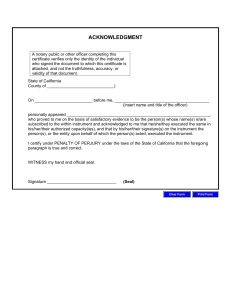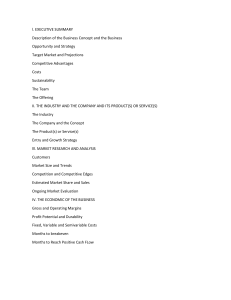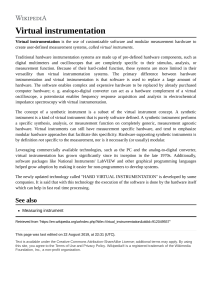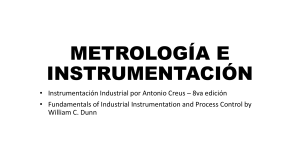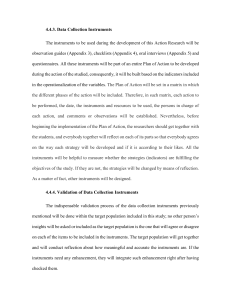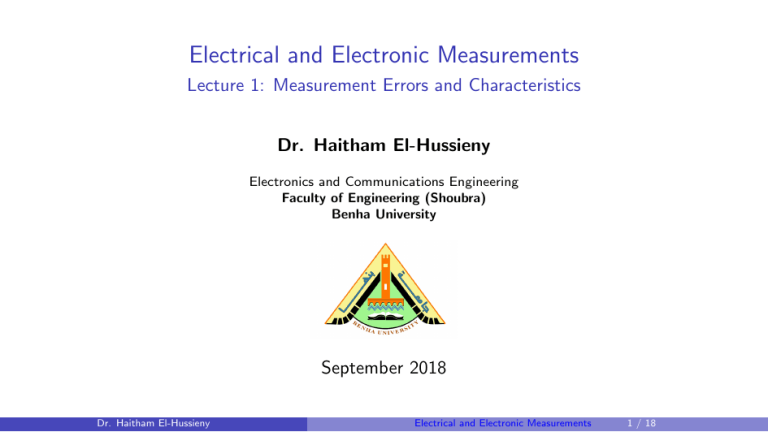
Electrical and Electronic Measurements Lecture 1: Measurement Errors and Characteristics Dr. Haitham El-Hussieny Electronics and Communications Engineering Faculty of Engineering (Shoubra) Benha University September 2018 Dr. Haitham El-Hussieny Electrical and Electronic Measurements 1 / 18 Lecture Outline: 1 Types of Measurement Errors. 2 Measurements Characteristics. Dr. Haitham El-Hussieny Electrical and Electronic Measurements 2 / 18 Table of Contents 1 Types of Measurement Errors. 2 Measurements Characteristics. Dr. Haitham El-Hussieny Electrical and Electronic Measurements 3 / 18 Measurement Errors: No electronic component or instrument is perfectly accurate; all have some error or inaccuracy. These errors are introduces due to either defect in the instrument, wrong observance, or environmental factors. These errors could combine to either: I I Completely cancel each others. Create greater errors in measurement (Worst case) The worst case should always considered while performing measurement, where these errors could combine to create larger error. Dr. Haitham El-Hussieny Electrical and Electronic Measurements 4 / 18 Measurement Errors: Measurement errors can be categorized into three types: Measurement Errors Gross Error Systematic Error Random Error Example Gross Error (Human Error) Errors due to human mistakes in using instruments, recording observations, and calculating measurement results. Dr. Haitham El-Hussieny Misunderstanding the unit in case of digital devices (21 V instead of 21 mV). A wrong scale may be chosen in analog instruments. Transpose of the readings while recording. (24.9 mV instead of 29.4 mV). Electrical and Electronic Measurements 5 / 18 Measurement Errors: Measurement errors can be categorized into three types: Measurement Errors Gross Error Systematic Error Errors due to problems with instruments. Dr. Haitham El-Hussieny Systematic Error Random Error Instrument Errors: May be due to incorrect device calibration. Environmental Errors: Change in environmental conditions may change some of device parameters. Observational Errors: Errors introduced by the observer as the parallax error. Electrical and Electronic Measurements 6 / 18 Measurement Errors: Measurement errors can be categorized into three types: Measurement Errors Gross Error Systematic Error Random Error Systematic Error Errors due to problems with instruments. Parallax Error: Viewing measurement from different angles. Dr. Haitham El-Hussieny Electrical and Electronic Measurements 7 / 18 Measurement Errors: Measurement errors can be categorized into three types: Measurement Errors Gross Error Random Error Errors due to unknown factors. Dr. Haitham El-Hussieny Systematic Error Random Error These errors are relatively small. These errors can be reduced by increasing the number of readings and using arithmetic mean. Electrical and Electronic Measurements 8 / 18 Measurement Errors: Absolute and Relative Errors: The error in measuring instruments can be represented in two ways: Absolute and Relative Absolute Error (∆e) It is defined as the difference between the true At and the measured Am values. ∆e = Am − At Dr. Haitham El-Hussieny Example An ammeter reads 6.7 A and the true value of the current is 6.54 A. The absolute error is ∆e = Am − At = 6.7 − 6.54 = 0.16 A Electrical and Electronic Measurements 9 / 18 Measurement Errors: Absolute and Relative Errors: Example Relative Error (er ) It is defined as the ratio of the absolute error ∆e to the true value At of the quantity being measured. er = ∆e = Am − At = 2.45 − 2.5 = −0.05A ∆e At The relative error Percentage error %er = er × 100 = The current through a resistor is 2.5 A, but the measurement yields a value of 2.45 A. The absolute error is er = ∆e × 100 At −0.05 ∆e = = −0.02 At 2.5 The percentage relative error %er = er × 100 = −2% Dr. Haitham El-Hussieny Electrical and Electronic Measurements 10 / 18 Measurement Errors Combination of Errors Errors in Sum of quantities E = V1 + V2 = (V1 ± ∆V1 ) + (V2 ± ∆V2 ) = (V1 + V2 ) ± (∆V1 + ∆V2 ) Error in Sum Error in the sum of quantities equals the sum of absolute errors. Dr. Haitham El-Hussieny Electrical and Electronic Measurements 11 / 18 Measurement Errors Combination of Errors Errors in Difference of quantities E = V1 − V2 = (V1 ± ∆V1 ) − (V2 ± ∆V2 ) = (V1 − V2 ) ± (∆V1 + ∆V2 ) Error in Difference Error in the difference of quantities equals the sum of absolute errors. Dr. Haitham El-Hussieny Electrical and Electronic Measurements 12 / 18 Measurement Errors Combination of Errors Errors in Product of quantities P = EI = (E ± ∆E ) × (I ± ∆I ) = E .I ± E .∆I ± I .∆E ± ∆E .∆I ≈ E .I ± E .∆I ± I .∆E (∆E .∆I is very small) Percentage error in P is E .∆I + I .∆E × 100% E .I ∆I ∆E = + × 100% I E = (% error in I ) + (% error in E ) Percentage error in the product of quantities equals the sum of percentage errors %P = Dr. Haitham El-Hussieny Electrical and Electronic Measurements 13 / 18 Measurement Errors Combination of Errors Errors in Quotient of quantities R= E ± ∆E I ± ∆I Percentage error in R is %error in R = (% error in I ) + (% error in E ) Percentage error in the quotient of quantities equals the sum of percentage errors Quantity raised to a power: %error in AB = B(% error in A) Dr. Haitham El-Hussieny Electrical and Electronic Measurements 14 / 18 Table of Contents 1 Types of Measurement Errors. 2 Measurements Characteristics. Dr. Haitham El-Hussieny Electrical and Electronic Measurements 15 / 18 Measurements Characteristics: Accuracy and Precision: Accuracy Accuracy is defined as the degree of closeness of a measured value compared to the true value of the quantity to be measured. Precision Precision is defined as the degree of similarity of repeated measurements. Dr. Haitham El-Hussieny Electrical and Electronic Measurements 16 / 18 Measurements Characteristics: Resolution and Significant Figure: Resolution Resolution is defined as s the smallest change in the measured quantity to which an instrument will respond. Significant Figure Significant figure is defined as the number of digits used to represent a measured value. The more the number of significant figures, the more precise is the quantity. Dr. Haitham El-Hussieny Electrical and Electronic Measurements 17 / 18 End of Lecture Best Wishes [email protected] Dr. Haitham El-Hussieny Electrical and Electronic Measurements 18 / 18
